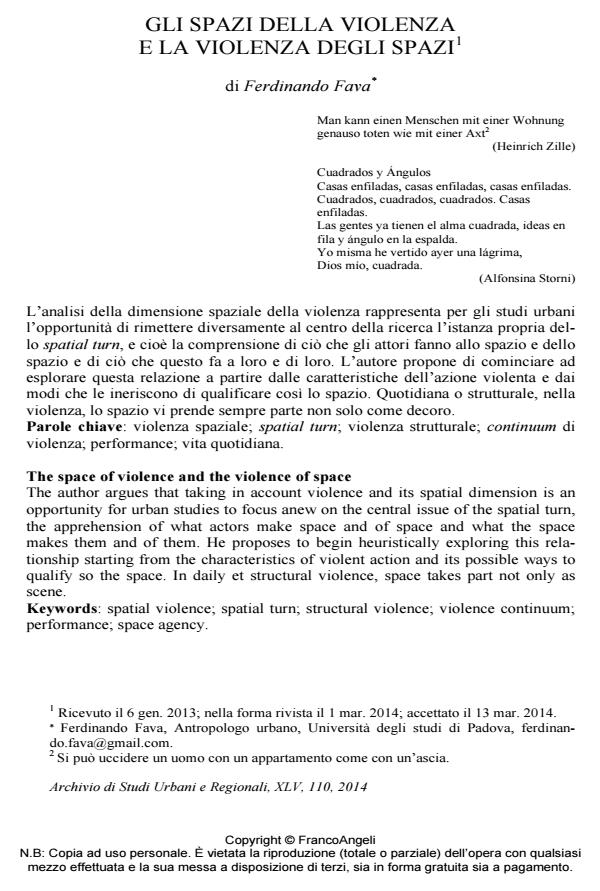Gli spazi della violenza e la violenza degli spazi
Titolo Rivista ARCHIVIO DI STUDI URBANI E REGIONALI
Autori/Curatori Ferdinando Fava
Anno di pubblicazione 2015 Fascicolo 2014/110 Lingua Italiano
Numero pagine 15 P. 25-39 Dimensione file 63 KB
DOI 10.3280/ASUR2014-110003
Il DOI è il codice a barre della proprietà intellettuale: per saperne di più
clicca qui
Qui sotto puoi vedere in anteprima la prima pagina di questo articolo.
Se questo articolo ti interessa, lo puoi acquistare (e scaricare in formato pdf) seguendo le facili indicazioni per acquistare il download credit. Acquista Download Credits per scaricare questo Articolo in formato PDF

FrancoAngeli è membro della Publishers International Linking Association, Inc (PILA)associazione indipendente e non profit per facilitare (attraverso i servizi tecnologici implementati da CrossRef.org) l’accesso degli studiosi ai contenuti digitali nelle pubblicazioni professionali e scientifiche
The author argues that taking in account violence and its spatial dimension is an opportunity for urban studies to focus anew on the central issue of the spatial turn, the apprehension of what actors make space and of space and what the space makes them and of them. He proposes to begin heuristically exploring this relationship starting from the characteristics of violent action and its possible ways to qualify so the space. In daily et structural violence, space takes part not only as scene.;
Keywords:Spatial violence; spatial turn; structural violence; violence continuum; performance; space agency
- Appel H. (2012). Walls and white elephants: Oil extraction responsibility and infrastructural violence in Equatorial Guinea. Ethnography, 13(4): 439-465. DOI: 10.1177/1466138111435741
- Bataille G. (1970). Ouvres Complètes. Paris: Gallimard.
- Bourdieu P. and Wacquant, L. (1992). An Invitation to Reflexive Sociology. Chicago: University of Chicago Press.
- Bourdieu P. and Johnson R. (1993). The Field of Cultural Production: Essays on Art and Literature. Oxford: Polity Press.
- Bourdieu P. (1998). La domination masculine. Paris: Seuil.
- Bourdieu P. (2000). Les structures sociales de l’économie. Paris: Editions du Seuil.
- Bourgois P. (1995). In Search of Respect: Selling Crack in El Barrio. Cambridge: Cambridge University Press.
- Bourgois P. (2001). The continuum of violence in war and peace: post-cold war lessons from El Salvador. Ethnography, 2(1): 5-34.
- Bourgois P. (2002). The Violence of Moral Binaries: Response to Leigh Binford. Ethnography, 3(2): 221-231.
- Bourgois P. and Sheper-Hughes, eds (2003). Violence in War and Peace: An Anthology (Wiley-Blackwell Readers in Anthropology). Oxford: Blackwell Publishing.
- Farmer P. (2004). An anthropology of structural violence. Current Anthropology, 45(3): 305-325.
- Foucault M. (1984). Des espaces autres. Architecture, Mouvement, Continuité, 5: 46-49.
- Foucault M. (2001). Space, knowledge, and power. Power: The Essential Works of Foucault, 1954-1984. Vol. 3. New York: New Press.
- Galtung J. (1975). Essays in Peace Research. Copenhagen: Christian Ejlers.
- Galtung J. (1990). Cultural Violence. Journal of Peace Research, 27(3): 291-305.
- Gell A. (1998). Art and Agency: An Anthropological Theory. Oxford: Clarendon.
- Ingold T. (2000). The Perception of the Environment: Essays in Livelihood, Dwelling and Skill. London and New York: Routledge.
- Ingold T. (2007). Materials against Materialism. Archaeological Dialogues, 14(1): 1-16. DOI: 10.1017/S1380203807002127
- Latour B. (1999). Pandora’s Hope: Essays on the Reality of Science Studies. Cambridge, Mass.: Harvard University Press.
- Lefebvre H. (1974). La Production de l’espace. Paris: Anthropos.
- Lefebvre H. (1996). Writings on Cities. London: Blackwell.
- Low S. (1990). The Built Environment and the Spatial Form. Annual Review of Anthropology, 19: 453-505. Quaderni di Sanità Pubblica (2003). Violenza e salute nel mondo. Rapporto dell’Organizzazione Mondiale della Sanità. Milano: CIS Editore.
- Rabinow P. (2003). Ordonnance, discipline, regulation: Some reflections on urbanism. In: Low S. and Lawrence-Zunigaisa D., eds, The Anthropology of Space and Place: Locating Culture. Oxford: Blackwell Publishing.
- Ricoeur P. (1990). Soi-même comme un autre. Paris: Editions du Seuil.
- Rodgers D. and O’Neill B. (2012). Infrastructural violence: introduction to special Issue. Ethnography, 13(4): 401-412. DOI: 10.1177/1466138111435738
- Rodgers D. (2012). Haussmannization in the tropics: Abject urbanism and infrastructural violence in Nicaragua. Ethnography, 13(4): 413-438. DOI: 10.1177/1466138111435740
- Sartre J.P. (1960). Critique de la Raison Dialectique. Paris: Gallimard.
- Scheper-Hughes N. (1993). Death Without Weeping: The Violence of Everyday Life in Brazil. Berkeley: University California Press.
- When interlocutors die: Time and space of mobility through the biography of a homeless man Paolo Grassi, in Ethnography /2021 pp.534
DOI: 10.1177/1466138119891453
Ferdinando Fava, Gli spazi della violenza e la violenza degli spazi in "ARCHIVIO DI STUDI URBANI E REGIONALI" 110/2014, pp 25-39, DOI: 10.3280/ASUR2014-110003